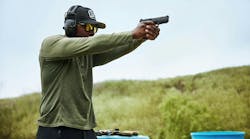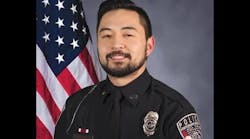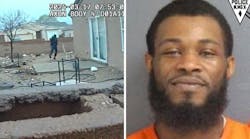Oct. 02--BRUNSWICK -- Seconds after two veteran Glynn County police officers fired eight bullets into the car of an unarmed woman they had been following in an erratic, low-speed pursuit, neither officer checked to see whether she was alive.
Instead, they talked about their marksmanship in what would become the fatal shooting of Caroline McGehee Small, a 35-year-old mother who had struggled with drugs much of her life.
"I hit her right in the face. ... Right on the bridge of the nose," the senior officer said.
"I think I fired twice," the other officer replied.
Later, that same officer told a former firefighter, "She's dead. I shot her in the head. Her head exploded."
Small was still alive, but barely. She died a week later when taken off life-support.
Those details, and more about the controversial June 2010 shooting of the unarmed woman, are among the evidence contained in a 540-page case file the Georgia Bureau of Investigation released to the Times-Union in response to an open records request.
Sgt. Corey Sasser and Officer Todd Simpson were cleared of criminal wrongdoing by a county grand jury in a split decision. Both also were cleared by an internal Glynn County Police investigation.
County Police Chief Matt Doering asked the GBI to investigate the shooting by Sasser and Simpson -- a common practice in officer-involved shootings in Georgia.
Then, as now, Doering maintains Sasser and Simpson acted reasonably and within department policy in the situation, which they perceived as life-threatening and endangering public safety. Officers considered Small's car a deadly weapon.
Police and state patrol car cameras recorded the chase, shooting and immediate aftermath. Sasser and Simpson were side-by-side off-camera, so none of the videos show either pulling the trigger.
"What a person looking at the videotapes can't see is the fear the officers felt," Doering said last week. "They can't see the same thing the officers saw because they are not looking at things through their eyes. The videotapes are not their [officers] perception."
The cameras did, however, record the officers' comments.
GBI officials declined comment about the findings, which offer no conclusions nor interpretation of the evidence.
The findings, however, raise issues sure to be the focus of a wrongful death lawsuit two Brunswick lawyers are preparing on behalf of Small's daughters, ages 5 and 12, and her estate.
"It's our opinion that the shooting was so far outside the realm of reasonableness that these officers need to be held accountable," one of the attorneys, Nathan Williams told the Times-Union.
Sasser, Simpson and a state trooper who tried to snatch Small out of the car right before the shooting, separately told GBI agents they believed she was a threat.
Simpson said it was a miracle that Small didn't kill someone. Sasser said he was scared for himself and Simpson, so he fired his weapon at Small, who had ignored repeated commands to surrender.
Trooper 1st Class Jonathan Malone of the Georgia State Patrol said he felt the Glynn officers and the public were in danger immediately after the chase. The danger, Malone said, was due to Small's unwillingness to stop and from her reckless driving.
Both Sasser and Simpson remain with the Glynn police department. Neither returned Times-Union telephone and email messages seeking comment. The lawyers who represented them when a Glynn County grand jury reviewed the shooting did not respond to Times-Union requests for comment.
Road of No Return
At the wheel of a battered 1991 Buick, Small had cocaine in her system, a half-empty bottle of vodka among several syringes in her car, and a history of running from police.
Heroin was Small's drug of choice, her father told GBI agents as she lay in a coma from which she would never awake. The Rev. Michael L. McGehee said his daughter was in and out of drug treatment programs much of her life.
The steak house waitress would binge on cocaine or whatever drug was available. Caught with a crack pipe, Small had been kicked out of a Brunswick halfway house the same day she moved in, just two days before she was shot, McGehee said.
Small was supposed to call him on June 18, 2010. Her call never came, McGehee told the agents.
The pursuit began when a Glynn police officer responded to a report of a woman shooting up heroin or cocaine in a car at the Embassy Suites parking lot at Glynn Place Mall.
Officer Peter Farrick told the GBI he found Small disheveled and glassy-eyed behind the wheel of the Buick. Small was picking at the empty car seat and looking under the console. When Farrick asked her to turn off the car, she instead slowly drove off, he said.
Both Sasser and Simpson were at police headquarters when the pursuit began. Sasser responded because he was the shift supervisor. Simpson told GBI agents he went out intending to deploy "stop sticks" to disable Small's car. At one point, Small nearly hit Simpson head-on during the chase.
It would take 30 minutes before Small, Sasser and Simpson met face-to-face.
Ignoring other motorists, pedestrians and traffic signals, Small led state troopers and police four miles through business parking lots, up and down residential streets and across yards until she careened down Armstrong Avenue.
After three attempts, Malone successfully used his patrol car to spin Small's car around and shove it off the street in the 200 block of Armstrong. Sasser quickly pulled up to the front of her car.
Boxed-in and with four tires shredded to the rims, Small had nowhere to go.
'Let me get her out'
The Buick came to rest with its trunk about two feet from a utility pole and mailbox. Malone's patrol car was jammed against the sedan's right rear quarter panel. Sasser later described his patrol car as "hood to hood" with her car. His front bumper was nearly touching hers, the GBI investigation showed.
There was a 73-inch-wide gap, however, on the passenger side of Small's car. Her Buick was about 70 inches wide. With little room to maneuver, Small tried anyway.
Throwing the car into reverse, she slammed into Malone's car, the utility pole and mailbox then drove straight forward into Sasser's car. Ignoring Sasser's shouted commands to "stop" and "get out of the car," Small ping-ponged back and forth, only moving about a foot, maybe two, in either direction.
Sasser was closest to her. Shielded by his open patrol car door, he was about 71/2 feet from where Small sat frantically working the gear shift on the steering column. To his left, Simpson was about 10 feet from Small. A third Glynn officer, Jason Dixon, stood to Simpson's left.
Malone made a dash to snatch Small out of the car. He told the GBI that Small tried to back into him but she hit the utility pole and mailbox instead. Malone retreated to the safety of his patrol car when he realized the Glynn officers were pointing their guns in his direction.
"Let me go in and get her out of the car," Malone is heard saying on the police videos after she reversed into his car, the pole and mailbox a second time.
"No. No. If she moves the car again, shoot her," Simpson replied.
The officers, Doering said, were trying to protect Malone because they didn't know if Small had a gun.
It's inconsistent with Glynn police training to run up to a suspect's car in those situations, he said.
"It's an ambush waiting to happen," the chief said. "You don't run up to the car."
Suddenly, gunfire erupted, the videotapes show.
Sasser and Simpson fired eight .45-caliber bullets at Small through the front windshield of her car as it lurched forward, again straight into Sasser's car.
Two bullets struck Small in the face and she slumped in the driver's seat.
Dixon walked up, looked in the driver's window at Small, then walked away. Neither Dixon, Sasser, Simpson nor any other Glynn officer ever touched Small to see if she had a pulse, the videos show.
"I don't know why they didn't. It's probably because in his assessment, Officer Dixon deemed there was nothing he could do for her," Doering said.
State troopers, however, checked her then administered emergency first aid until county paramedics took over about six minutes after the shooting.
'I Hit Her In The Face'
Sasser told GBI agents that he did check Small for a pulse, but she didn't have one. None of the police videos show him doing so.
Instead, he and Simpson talked about who shot first and where the bullets hit Small, according to the videos.
"I hit her right in the face ... Right on the bridge of the nose," Sasser said.
"I think I fired twice," Simpson replied.
"I shot first. You shot, blam, blam," Sasser told Simpson.
Sasser, who fired six bullets, told the GBI that his first shot hit Small and she "jerked back." Simpson told the GBI that "she came forward at us and that's when we shot."
Mitchell McDaniel, a former Glynn County firefighter, witnessed the shooting from about 25 yards away on a riding lawn mower in a yard across the street.
"The car was immobile. ... There was no way the car was going to run over the police officers," McDaniel told GBI agents.
McDaniel said he knew Simpson and talked mostly to him after the shooting. Simpson told him that he'd shot Small in the head. McDaniel asked Simpson whether he should go check on Small.
"He said, 'No, she's dead. I shot her in the head. Her head exploded,' " McDaniel told the GBI.
Small wasn't dead, but her gunshot wounds were far more serious than Doering told reporters immediately after the shooting.
Doering said a bullet struck her in the cheek but that Small was taken to a Savannah hospital where she was in stable condition and expected to fully recover.
Small died one week later without regaining consciousness when her family allowed doctors to remove her from life support.
Acknowledging he was wrong then, Doering said that was the initial information he had been given.
Either of the two police bullets, individually or collectively, could have been lethal, autopsy results showed.
It's unknown which officer or whether both fired the fatal shots. Because the bullets fragmented upon impact, GBI ballistics experts couldn't match them to either Sasser's or Simpson's department-issued Glock semi-automatic handgun.
Officers' histories
It wasn't the first time Sasser had shot a suspect in the line of duty.
On Jan. 26, 2005, Sasser shot a convicted drug dealer, whom an internal investigation showed was trying to run down Sasser. Before jumping out of the way, Sasser, who joined the department in 2001, fired three bullets into the man's car -- one through the front windshield and two through the open driver's window. Sasser wounded the man in the upper right shoulder and forearm. The man later was sentenced to 10 years in prison after he pleaded guilty to aggravated assault on a peace officer.
In his 15 years on the force, Simpson had never before fired his gun in the line of duty.
Grand Jury's Decision
In a 12-6 decision, a Glynn County grand jury cleared Sasser and Simpson of criminal wrongdoing in Small's death.
The panel heard more than six hours of evidence ranging from the police car videos to testimony from Sasser, Simpson and two other law enforcement officers present when the shooting occurred. Its Aug. 17 special presentment stated that Sasser and Simpson "acted lawfully and were justified in their conduct."
District Attorney Jackie Johnson had prepared a potential indictment charging Sasser and Simpson with felony murder, voluntary manslaughter, two counts of involuntary manslaughter and one count of violation of their oath of office in Small's death. A copy of the indictment is in the GBI case file. Johnson declined comment about whether the grand jury considered the indictment.
Unless new evidence surfaces, Johnson said she won't present the case to a new grand jury, which the law allows in certain circumstances.
By the time the grand jury convened, Sasser and Simpson already had been cleared by a Glynn County police internal investigation.
Georgia law allows the family to ask for a special prosecutor, an option Williams, the attorney preparing the lawsuit on behalf of Small's daughters, said has not been ruled out.
Teresa Stepzinski: (912) 264-0405


